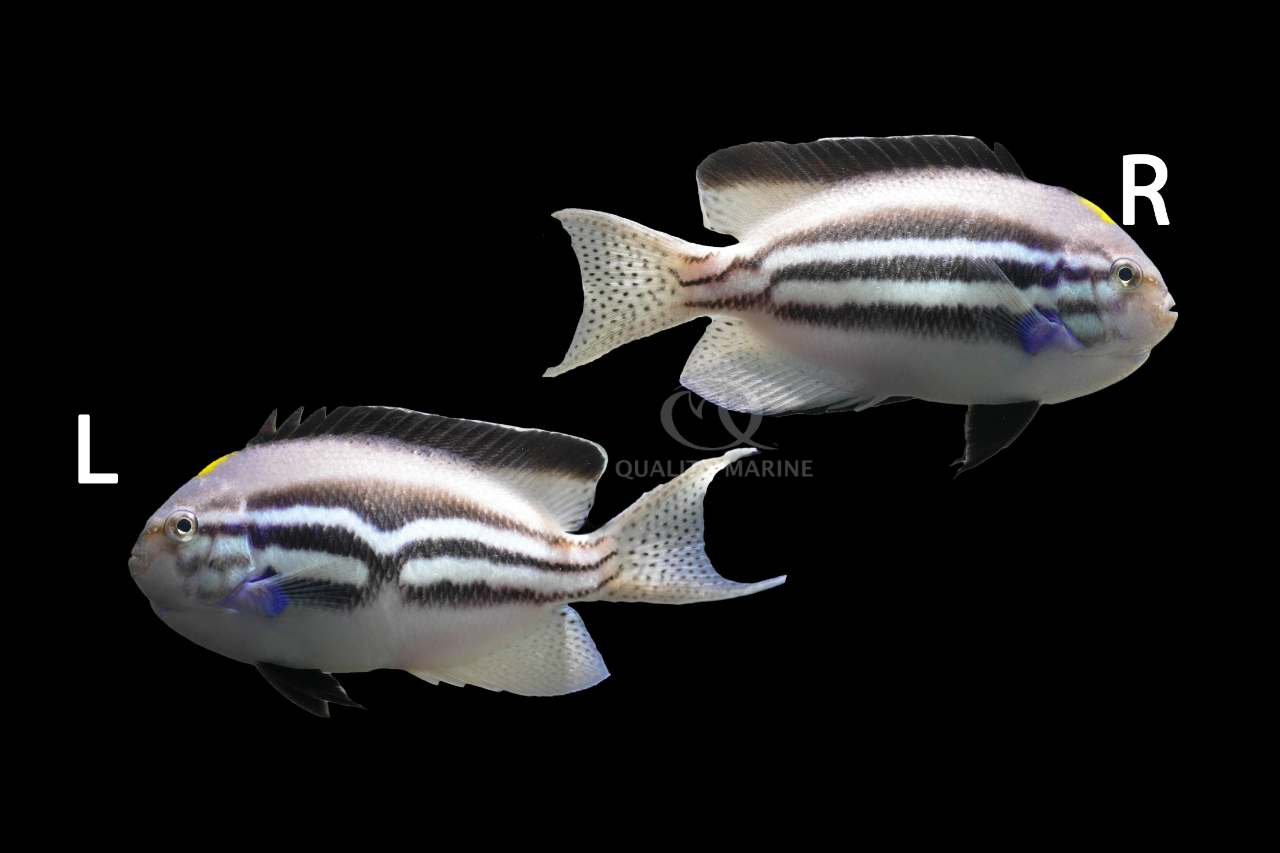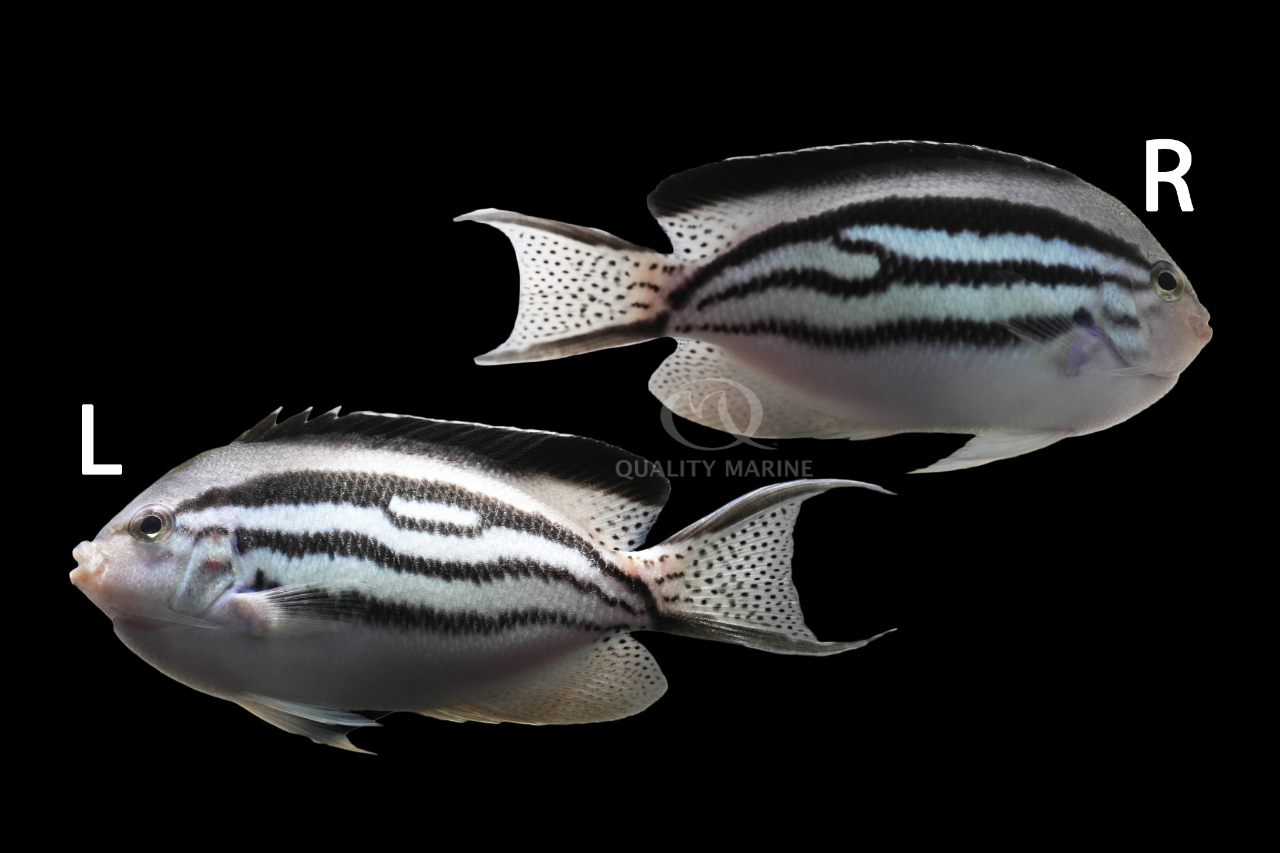Lamazing Lamarck

We all love Angels around here, from the littlest Argi, to the biggest Emperor, there's a lot to love about all of them in the right display. The single catch to this gorgeous group of fish, is that the vast majority of them aren't trustable in our reef tanks. Even some of the Centropyge that are model citizens just might one day decide that the Strawberry Shortcake Acro you've been growing for 10 years looks as tasty as it sounds and munch on it. However, there is one genus of Angelfish that isn't a risk this way, and it is Genicanthus. These planktivores (animal that eats plankton or other suspended foods), aren't natural grazers and as such, are very unlikely to ever look at your corals, sponges and other sessile (stuck in one place) invertebrates as food.

One of our favorites of this genus is Genicanthus lamarck, which is a gorgeous Angelfish, whose silvery-blue body is lined with three to six black stripes and topped with a black fin. While both sexes will develop deeply spotted, swallow shaped tail fins, those found on the male will be more enhanced; males can also develop a yellow spot on their forehead and blue spots near their pectoral fins. These are stunning fish at any time, but right now, (March 2024) we also have some that have unique, aberrant barring, and you'll want to ask your LFS about them as soon as possible!
Most often called Lamarck's (or Lamarcki) Angels, these fish are also sometimes called Blackstripe Angel and Freckletail Angel. They are a common fish in the Pacific portion of their wild range, though they have also been documented in the Red Sea and Indian Ocean, albeit much less frequently. Lamarks are usually collected near tropical reefs in water that is between 50 and 150 feet deep. In the wild, they are schooling fish that live in small groups that usually feature one male and between two and six females (a distribution referred to as haremic).
The largest Lamarck's Angelfish on record is just shy of ten inches, but there isn't a good record of this. If they can actually reach this size, it happens very slowly, and they can be sexually mature at less than half that length. A much more common adult size is five to six inches long making it a relatively small fish as far as Angels go. That being said, we still recommend keeping them in a tank that is 125 gallons or more, especially if you opt to keep more than one of them. The emphasis should be on swimming space instead of depth. They are strong swimmers and will utilize all the room you give them. Flow should be strong and so should filtration. While they are not known as jumpers, they can swim very quickly when startled, and could easily jump out of a display that wasn't covered. They will appreciate substantial rockwork both for hiding in and swimming through. The more places they can hide, the more you will see them.

Lamarck's Angels are very hardy fish and are not especially sensitive to different water quality parameters. Whatever parameters you shoot for, make stability of these a priority. Temperature will be okay anywhere from 70 to 78. Salinity could range from 1.021 to 1.026, and pH should be as stable as possible between 8.0 and 8.4. They will do best in aquariums with light nutrient loads and so strive to keep your nitrates under 10ppm. A regular water change schedule will help maintain the nutrients and the pH you're shooting for.
One of the really great things about fish that are planktivores is that their entire mechanism for feeding is just eating whatever the current brings them. This means that they are well adjusted to a wide range of foods, and thus they adapt well to the foods that are easily available to the home hobbyist. Here we feed them a meaty mix of foods from Gamma, including mysis, brine, and a variety of chopped product like mussels, shrimp and fish. They also learn how to take pellets quickly when introduced at the same time as the meaty food. To this end, we add Nutramar Complete Pellets to their diet. They should be fed at least twice a day to help offset their high activity level.
In addition to their ease of feeding, one of the attributes that endear Lamarck's Angels to everyone is their temperament. This is a peaceful fish that will generally not harass the other, smaller denizens of the aquarium. They don't necessarily need to be in groups, but they can be shy when initially introduced and this effect will be lessened if there is more than one of them. When kept this way, take care to ensure you only have one male. This isn't too hard to achieve as the males are noticeably different as we touched on earlier. They will also do fine with other genus of Angelfish, with exception of a few that are too aggressive to keep with the Lamarck's. We don't recommend keeping them any extremely aggressive fish as they will be bullied into hiding and miss mealtimes. Having other fish in the aquarium will also help these Angels feel more quickly at home.
If you've been looking for the kind of showpiece Angelfish that can live in your reef tank, your lucky day has arrived. There are few better choices for any aquarium that Lamarck's Angels. Hardy, beautiful, reef safe and the aberrant ones we have in house right now add rarity to this already amazing list of attributes! Head over to your LFS, ASAP, and ask them about Misbar Lamarck Angelfish from Quality Marine today!